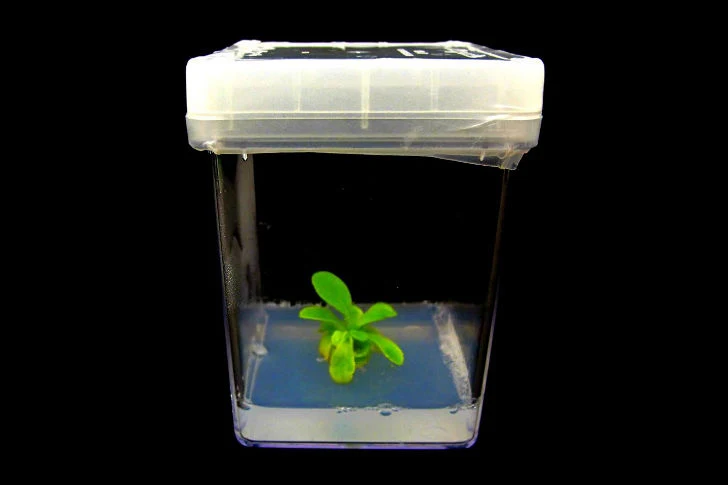MIT engineers just unveiled living, glowing plants / Seon-Yeong Kwak Bioluminescence is the production and emission of light by ...
 |
| MIT engineers just unveiled living, glowing plants / Seon-Yeong Kwak |
Why use a light bulb to illuminate your home when you could just fill it with glowing plants? That’s the question asked by Antony Evans, the head of a team of bio-engineers in San Francisco, California. The team has launched a Kickstarter campaign to fund a project that will use the glowing genes from fireflies and bioluminescent bacteria that to create plants that glow with the light. By using synthetic biology and Genome Compiler software, the have already managed to modify Arabidopsis plants, and they’re working on glowing roses.
While this is not the first time that luciferase has been used to make a plant light up, it is the first instance where scientists have been able to get the gene to recycle itself and make the plant especially bright. Not surprisingly, the team has already surpassed their $65,000 Kickstarter goal. Through their project, they hope to educate the public on the potential for bioluminescent lighting, and to one day help curb the energy needed to power lighting systems. Backers who pledge $40 or more will receive a packet of 50-100 seeds that will only be available through Kickstarter.
A pledge of $150 or more will get you a fully grown glowing plant that is ready to brighten up your home or office. The project is a part of a growing movement to promote biological engineering for the next generation of design. Glowing plants might sound like the stuff of science fiction – but a team of MIT researchers just grew a crop of watercress that emits emit dim light for almost four hours.
Postdoctoral researcher Seon-Yeong Kwak led a team of engineers and scientists to instill the plants with the same enzyme that makes fireflies sparkle. MIT chemical engineering professor Michael Strano said, “The vision is to make a plant that will function as a desk lamp – a lamp that you don’t have to plug in. The light is ultimately powered by the energy metabolism of the plant itself.”
Plant lamps or even tree street lights could brighten our world in the future thanks to recent research on glowing plants. The plants are illuminated by luciferase – the same enzyme that helps fireflies shine. Luciferase acts on the molecule luciferin to give off light. The team put these three components into nanoparticle carriers to get them to the correct part of a plant.
The scientists showed they can also turn off the light by adding nanoparticles with a luciferase inhibitor, so they think they could eventually create plants that stop emitting light in response to conditions like sunlight. Past experiments to create light-emitting plants attempted to genetically engineer plants to express the gene for luciferase, according to MIT. But it’s a process that takes a lot of work for very dim light – and it’s often limited to just one plant type.
The new MIT process can work on any kind of plant; so far the scientists have demonstrated it with watercress, kale, arugula, and spinach. They hope to be able to spray or paint the nanoparticles on leaves with future iterations, so trees or large plants could serve as light sources. The journal Nano Letters published the research online in November. Scientists from the University of California, Riverside and the University of California, Berkeley contributed to the work.
Taking a cue from fireflies, scientists have created the world's first light producing plant, and you can have one for your very self. Bioglow's autoluminscent plant the Starlight Avatar™, glows in the dark and could usher in a new era of living lights. The little plant has been engineered to produce its own light and 20 will soon be up for auction.
Missouri-based Bioglow has been working on light-producing plants for a number of years and finally has one that they can sell. Starlight Avatar™ is an auto luminescent plant that generates light through its own pathways and does not require UV light or chemical additives. The light producing plant was made by taking an ornamental Nicotiana alata plant and introducing the light-emitting pathway from marine bacteria into its chloroplast genome.
The genetically modified plant then glows a soft blue-green in the dark and could be used for decorative purposes, but is hardly bright enough to read with. Bioglow hopes to improve their techniques and strengthen the light production capabilities. They foresee a time when the plants are used as decorative landscaping that could eliminate the need for night time lighting and decrease emissions from electricity use.
Bioglow also hopes to create plants the emit red or other colored lights and maybe even use the plants to serve pollution or stress sensors. Want your very own light producing plant? At the end of January, Bioglow will be auctioning off 20 Starlight Avatar™ plants with a starting bid of $1. The plants will come in their own cultivation boxes and are expected to produce light through their lifespan, which lasts about 2-3 months.











